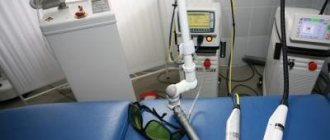Make an appointment with a urologist by phone or by filling out the online form
| Select a clinic | Venereologist | Removal of condylomas | Calling a venereologist to your home |
Genital warts in men
occur quite often and even according to statistical data, the majority of people on our planet are carriers of this virus. Moreover, among male representatives, such troubles often turn out to be the result of excessively free sexual relations.
Externally, condylomas are skin neoplasms with a dense structure. As a rule, they occur in areas characterized by humidity and warmth. Most often this is the genital organ, its frenulum, the scrotum area, near the anus. Less commonly, condylomas are found directly inside the oral cavity.
general information
Condylomas are a benign tumor formation that is “located” on the epidermis or mucous tissues and looks like warts and papillae. Single specimens (about 7 mm) or entire “colonial formations” (up to several tens of mm) of condylomas settle on the body of women and men and often resemble cauliflower in appearance. The color of these substances ranges from flesh-colored to brown. Condylomas are viral in nature, so such problems can even occur in children (during childbirth from an infected mother). As long as the growth has not reached the epidermis, the person does not pose a threat to others; the risk of infection increases if the growths are located in the epidermal layer. Condylomas are usually divided into two types:
- wide;
- pointed.
In the first case, condylomas in women and men look like a mushroom with a cap and a wide stalk and are most often a consequence of secondary stage syphilis. Condylomas of the genital type are transmitted through sexual relations; the human papillomavirus (HPV), which is activated under certain conditions, is involved in their appearance. The main location of genital warts is the genitals and oral cavity. Condylomas in women settle on the outer and inner parts of the labia, in the vagina, clitoris and anus. Warts and papillary growths in men select the glans penis and frenulum of the foreskin.
Why are condylomas in intimate places dangerous?
Patients are of course interested in the question: is genital warts dangerous or not? Often, the development of such formations on the body indicates the presence of completely different diseases that are transmitted through sexual contact. That is why special attention should be paid to the test results. In addition, the papilloma virus reduces the patient’s immunity, and any existing chronic diseases will be exacerbated.
Genital warts themselves are a source of infection; during childbirth it can become the main source of infection. Tumors during this period can grow quite strongly and increase in size.
Natural childbirth is often contraindicated, and women in labor undergo a cesarean section. But the greatest danger of developing condylomas is their degeneration into a malignant tumor. This happens mainly when the disease is in an advanced stage of development. That is why condylomas in intimate places must be treated.
Reasons for appearance
“What causes condylomas?” - a question that worries patients with a similar problem. The route of infection with condylomas is through unprotected sexual contact. Moreover, these include traditional intimate relationships, as well as oral, anal and homosexual relationships. Children get the disease from sick women while moving through the birth canal. Do not be negligent about household methods of infection. There is no need to take risks and use other people’s personal belongings, especially bath accessories (washcloth, towel, flip flops, etc.). Condylomas are activated under the influence of certain factors:
- indiscriminate unprotected sex;
- early onset of intimate relationships;
- sexual contacts with partners with condylomas or HPV carriers;
- decreased immune abilities of the body;
- previous diseases of the genital tract;
- frequent stress, vitamin deficiency;
- sloppiness and failure to comply with personal hygiene rules.
The appearance of genital warts is often associated with HPV. Human papillomavirus infection poses a great danger for the development of cancer. Condylomas of this etiology are the object of study and treatment by doctors of different specializations: in women - by gynecologists, in men - by urologists. If the location of condylomas is in the anal area, then a proctologist leads the patients. You should definitely consult about genital warts, because the development of the disease can occur in a variety of ways - from self-healing to the degeneration of condylomas into malignant formations. The specialists of the Global Clinic Center have accumulated positive experience in solving such problems, so contacting the clinic is a prerequisite for successful treatment of the patient.
How can you become infected with condylomatosis?
There are over 100 types of human papillomavirus that can affect people of any age, status and gender. In most cases, the virus affects human skin. The urogenital type of the disease is the most unpleasant in manifestation and treatment, but also one of the most dangerous types of papillomatosis.
Pubic growths not only create discomfort, but also cause pain or burning. In the later stages of the disease, when acute symptoms appear, a person cannot go to the toilet or have sex without pain. Under no circumstances should you delay the treatment of pubic disease. Pubic growths occur in people who are sexually active. The domestic method of infection is less common, but it cannot be ruled out by the doctor. A person who uses other people’s personal hygiene products and is negligent about their own health can become infected with the virus.
The papilloma virus is transmitted from mother to child during pregnancy. Such infection occurs extremely rarely, and the disease manifests itself in the first months of the baby’s life.
An important condition for the development of the genital type of disease is weak immunity. After treatment or removal of a growth, the patient must undergo rehabilitation. At the end of therapy, disease prevention consists of increasing the body’s defense mechanisms and caring for the pubis, perineum, and genitals. Daily hygiene of intimate areas allows you to delay the recurrence of an unpleasant disease that causes the formation of growths around the genitals. Where do warts appear in men and women?
Itching in the groin accompanies the growth of condylomas
Symptoms
The main manifestation of growths is their unpleasant and repulsive appearance. But women will also be reminded of condylomas by other unpleasant moments. The time elapsed from the first contact-infection to the moment when condylomas become clearly visible can be completely different. Sometimes a week or a month is enough for condylomas to appear; in other situations, years may pass. The incubation period depends on the general health of the woman or man, their immunity, lifestyle, etc. Condylomas in women and men cause itching and burning in the genital area and near the anus. This occurs during the period of germination of condylomas; in the future, such symptoms may disappear. An increase in the amount of whitish discharge, sometimes mixed with blood and an unpleasant odor, provokes condylomas in women, which are localized on the vaginal mucosa or cervix. When condylomas are found in the anus, the passage of feces can injure them and cause ichor.
General symptoms of the disease
The disease manifests itself depending on the condition of the patient’s body and his lifestyle. The virus manifests itself faster if a person suffers from systematic diseases, vitamin deficiency or sexually transmitted diseases. The growths are located on the groin, head of the penis, foreskin, vulva and labia. The anus may be affected by tumors. Infection during sexual intercourse is the most common reason why genital warts appear on the skin. The first symptoms will allow you to identify the disease in the early stages and begin timely treatment.
The main signs of infection with the papilloma virus:
- growing blisters on the labia or pubis;
- severe itching and burning;
- pain;
- inflammatory processes in intimate areas;
- discomfort;
- general weakening of the immune system and apathy.
General symptoms and comorbidities affect the patient's life. The person is ashamed of his own problem and often delays treatment. Growths can appear on any part of the pubis or on the skin around the anus. Multiple papillae that appear on the anal mucosa indicate an advanced form of the disease. Small warts gather into conglomerates that become inflamed.
Damaged papillomas during sexual intercourse can infect a healthy person. The scales of the neoplasms fall on the mucous membrane of the partner’s genital organs, after which infection occurs. Over 50% of the world's population is infected with various types of papillomavirus, so experts recommend taking the choice of a sexual partner seriously. A viral infection that is asymptomatic can develop into cancer or lead to diseases of the genital organs. Every day of delay can cost the patient health and a full, active life. How is condyloma diagnosed?
Apathy and weakness accompany the development of condylomas
Pathogenesis of genital warts
HPV is found in the cellular structures of the skin and mucous membranes, so it can be transmitted from men to women, from adults to children. The long latent period of infection makes early diagnosis of the disease difficult. Condylomas are not immediately visible to the naked eye. To activate HPV, a large number of these pathogens is necessary, only then the papillomavirus “comes out”, represented by genital warts. An increase in HPV may occur due to decreased immunity in women or men. Genital condylomas are caused by the process of atypical reproduction of the human papilloma virus; under its influence, epithelial cells grow and develop with pathology. The skin and mucous tissues change and this is how condylomas appear. Growths in the form of warts and papillae can be single or massive, turning into entire “conglomerates” of condylomas.
Treatment of condyloma in women
The exophytic form of genital warts, which means that they are located externally, affecting the genital area, but sometimes localized in other places, causing discomfort and anxiety. It is very important to promptly treat condyloma in women, which can cause bleeding and other complications that are harmful to health.
Symptoms of condylomas in women
Several condylomas appear symptomatically in women at the same time; they are located in a group, in places where maceration of the skin is increased. This means they can be found on a woman’s clitoris, vagina, labia, and even the cervix. The anal area is often affected by condylomas. The penetration of the condyloma virus is facilitated by microtraumas of the skin and mucous membranes during sexual intercourse, therefore genital warts are classified as sexually transmitted infections that require treatment.
Treatment of genital warts in women
The most radical and most commonly used method of treating condylomas is surgery. Laser coagulation of condylomas is a fairly effective method and the treatment of condyloma in women is quite successful. You can also use liquid nitrogen for cryotherapy to eliminate condylomas in women, as well as electrocoagulation as one of the methods.
This is interesting: Condylomas on eggs
What makes timely diagnosis of the disease in women very difficult is its prolonged latent period; sometimes several years can pass from infection to obvious symptoms. And at some point, most often when the immune system is weakened by some unfavorable factors, an acute outbreak of genital warts in women may occur. Basically, pinkish growths are suddenly noticed on the genitals, resembling cauliflower in appearance. The development and resolution of the disease is directly related to the state of the immune system. Genital warts in women can either appear unexpectedly or disappear imperceptibly, but in some cases, medical intervention is still required to exclude and avoid complications.
Condylomas in women: common complications
What complications threaten the appearance of genital warts in women? The main inconvenience is that during sexual intercourse, condylomas are injured and cause bleeding, and sexual intercourse itself is difficult. And the psychological discomfort caused by the presence of condylomas is clearly not beneficial to health, both mental and physical. For women, the presence of these growths during pregnancy is especially dangerous, as childbirth can be complicated. If condylomas are not treated, in some cases they can provoke the development of a disease such as cervical dysplasia, and are also a provoking factor for the development of oncological processes. Timely seeking of medical help by a woman for condylomas will help maintain both health and mental comfort.
Prevention of treatment of condylomas
HPV carriers should remember that modern science is not able to remove all traces of the condyloma virus from the human body, whether through cauterization of condylomas, laser removal or other methods of treatment. And with a decrease in immunity, the condyloma virus can make itself felt with renewed vigor. Therefore, good health and high immunity are the first things that those who have had condylomas should take care of. In specialized institutions, you can receive instructions and undergo a course of treatment aimed at improving the human immune system.
Condyloma on the labia often occurs in women who are of childbearing age.
Diagnostics
Human papillomavirus infection (genital warts) is diagnosed in different ways, from visual examination of women and men to the most advanced examinations. CM "Global Clinic" has in its arsenal the latest techniques for determining the nature of condylomas. Diagnostic methods used by doctors:
- Clinical examination. Some types of diseases in women and men can be masked, taking the form of genital warts, so you need to have sufficient qualifications to differentiate different problems.
- Colposcopy is recommended for women, and urethroscopy for men.
- A smear will tell a lot about condylomas in women and their nature; this cytotest will also help to exclude cervical dysplasia.
- Histology.
- Diagnostics-PCR. This examination not only detects the presence of human papillomavirus, but also determines its type.
- Immunological research. It is used to detect antibodies to HPV in the blood.
All women and men affected by genital warts must be tested for infectious diseases of the genital area (syphilis, HIV, etc.)
Removal and treatment of condylomas
Human papillomavirus is treatable. The following types of treatment for condylomas are distinguished:
Thermocoagulation of condylomas - from the Greek. therme - warmth. Treatment of condylomas under the influence of high temperatures.
Radiosurgical removal of condylomas. One of the methods for treating HPV and condylomas is using a special radio wave surgery device that produces a beam of high-frequency radio waves.
Chemical destruction of condylomas is a method of treating condylomas with special preparations containing concentrated nitric acid.
Laser destruction is the treatment of condylomas using a special laser.
Cryodestruction of condylomas - One of the types of treatment is cauterization of condylomas with liquid nitrogen. When liquid nitrogen is applied to condylomas, they are cauterized and destroyed under the influence of low temperatures. It is believed that this method of cauterization of condylomas is very effective and low cost. However, treatment of condylomas should only be carried out with a professional doctor in specialized institutions. After all, cauterization of condylomas with liquid nitrogen requires care and professionalism. Otherwise, the patient risks getting a burn to the genitals.
Treatment
Condylomas and HPV require a systematic approach to treatment.
Medication
To combat condylomas in women and men, doctors act in three directions:
- against viruses;
- in order to increase immunity;
- for fortification of the patient.
Cycloferon and inosiplex act against HPV activation and its reproduction. Inferon and allokin-alpha stop viruses and help restore the immune system. To improve the general health of women and men, Immunal, Amixin, Poludan, etc. are prescribed. A complex of vitamins and minerals is also an essential component of treatment for condylomas.
Local
Condylomas are successfully treated using ointments and sprays of antiviral action (epigen-intim, condylen, etc.). Women and men will not have to think about condylomas if they are treated with inquimod, podophyllotoxin. For pregnant women, you can use trichloroacetic and nitric acids. Women need to fight condylomas in stages: first remove them, and then, or in parallel, act to reduce the number of viruses. Often (in every third woman) condylomas enter the stage of relapse (especially if preventive measures are not followed and the recommendations of the attending physician are ignored).
Removal
Methods for removing condylomas in modern medicine are varied:
- Electric coagulation. This method has disadvantages - many contraindications, painful procedure and long recovery.
- Cryotherapy. Condylomas are removed using liquid nitrogen. The positive aspects of this technique are the absence of scars, painless effects, and the absence of anesthesia.
- Surgical method. The growths are removed during surgery, and stitches are placed at the site of the wounds. Doctors use local anesthesia.
- Use of chemicals. This method is contraindicated during pregnancy and lactation.
- Laser therapy. Condylomas are removed with a laser beam; this is a treatment that does not affect healthy cells and leaves virtually no scars.
- Radiosurgical method. The use of a special device helps remove condylomas without contact with the body. Removal of growths is accompanied by simultaneous sealing of blood vessels. This technique is one of the most modern and in demand.
Condylomas on the genital organs: what kind of pathology is this?
Condylomas on the genital organ in men or women are specific growths that are represented by fibroepithelial tissue.
In most cases, as doctors note, there is no difference in color from the main skin.
But there is an exception: new growths can have both a darker and lighter color.
It is also important to remember that condyloma can grow either on a wide base or on a thin stalk.
The method of removing the growth often depends on the method of growth.
Many patients ask their doctors where condylomas come from.
Their appearance on the skin is a consequence of exposure to the human papillomavirus.
This virus, entering the human body, exists in it for the rest of its life.
But it usually manifests itself only if there is a decrease in immunity.
The main route of infection is sexual.
Moreover, anal or oral contact may be sufficient for the development of the disease.
It is a mistake to believe that HPV is only spread through vaginal sex.
Additionally, the disease can spread through contact and household contact, as well as from mother to fetus.
According to the most approximate statistical data, about 7 out of 10 residents of the Russian Federation suffer from HPV.
In this regard, the question is not so much in preventing infection, but in getting rid of its consequences.
Reasons for the development of condyloma on the genitals
Condylomas of female genital organs are found in medical practice as often as those of males.
Patients are perplexed: if the virus is in the body of most people, then why not everyone suffers from its manifestations.
It’s very simple: it’s a matter of the patient’s immune system activity.
If the immune system is working at full strength, viral particles cannot fully multiply, infecting a larger number of tissues.
And, accordingly, there are no symptoms of the disease.
If the immune system fails, the virus begins to actively multiply and negative symptoms appear.
Doctors name a number of factors that can contribute to a decline in immunity.
Among them:
- the presence of various sexually transmitted diseases in the patient’s history;
- lack of vitamins, micro- and macronutrients;
- exposure to severe stress, constant psycho-emotional stress;
- the period of pregnancy and childbirth, during which immunity also drops quite significantly;
- disruption of the normal vaginal microflora;
- frequent hypothermia;
- failure to comply with basic hygiene rules and recommendations for caring for the genital area.
Depending on the individual characteristics of the patient, exposure to one of the factors may be sufficient for the development of the disease.
People with strong immunity live for years under the influence of, for example, stress, without experiencing problems.
Diagnosis of genital warts
Genital condylomas in women and men usually do not pose difficulties in making a diagnosis.
Before giving any recommendations, the doctor must examine the patient and talk with him about his medical history.
Once the data is collected, testing methods and diagnosis of the disease can be selected.
In most cases, polymerase chain reaction is used as the main diagnostic method, as is the case with other viruses.
The need for its use is explained by the fact that the virus is not visible under a microscope.
This means that microscopy as a method of diagnosis loses its meaning.
The essence of the polymerase chain reaction is simple.
Using a special device, pathogen DNA is isolated from biological material.
It is multiplied many times so that it can be assessed and differentiated.
For obvious rashes in the genital area, PCR is more likely to be confirmatory.
Additionally, Digene-Test and PAP test can be used for diagnosis.
Both of these techniques are used in medical practice much less frequently than the polymerase chain reaction.
But if necessary and if there are specific indications, they can be used.
Why is therapy for genital warts necessary?
Condylomas of the external genitalia are a serious aesthetic defect.
However, they often do not cause other inconveniences, forcing the patient to worry only about his own beauty.
In this regard, many patients have a question.
Why undergo any therapy and waste time and money on treatment?
After all, it is still impossible to completely get rid of viral particles in the blood.
Despite the fact that HPV is a chronic infection prone to exacerbations, doctors still recommend treating the disease.
This is explained by the fact that viral particles, entering new cells, cause a large number of mutations in them.
Cells that previously developed normally change their structure and can become malignant.
The threat of oncological degeneration of tumors on the skin is the most serious threat when HPV affects the genital organs.
It is also important to remember the following.
The presence of growths in places that are not suitable for this can lead to trauma and irritation of the skin.
Often, if condylomas are injured, pathogenic microorganisms settle on them.
What causes a secondary infection to develop?
To avoid these complications, patients are recommended to undergo comprehensive treatment.
Conservative treatment of genital warts
Today there is no uniform treatment regimen for genital warts.
In this regard, each doctor selects medications for the patient individually, focusing on his condition and the severity of symptoms.
It is important to remember that it is impossible to completely suppress the infectious process.
But it is possible to stimulate the immune system so that it again does not allow the virus to manifest itself clinically.
You can also try to reduce the viral load, which is considered an important step in therapy.
This is interesting: What are condylomas and what do they look like?
Patients with HPV are prescribed both local and systemic therapy.
For systemic treatment the following are used:
- antiviral drugs (most often the use of Isoprinosine is recommended);
- immunostimulants such as Viferon, Cycloferon, etc.;
- vitamin therapy.
Thanks to systemic medications, it is possible to correct the body’s immune status.
Also normalize metabolic processes that may suffer due to a lack of vitamins.
You should get recommendations on what doses and for how long to take certain medications from your doctor.
The dosage and duration of administration are always chosen individually.
Depends on the characteristics of the patient’s disease.
Ointments and creams for genital warts
Medications for treatment are not limited to systemic drugs.
Often, ointments and creams are an essential component of complete therapy.
Using external treatment products you can achieve various effects.
Those. reduce the severity of inflammation, improve local immunity.
Suppress viral activity at the local level, prevent the development of secondary infection in case of condyloma trauma.
Effective ointments are selected in each individual case by the attending physician.
Most of them have a cauterizing effect.
Thanks to this, it can cope with small-sized growths without invasive interventions.
For example, we can recommend:
- Salicylic ointment;
- Acyclovir (usually used to treat herpes, but in some cases is effective in treating HPV);
- Okoslin ointment;
- Viferon and others.
Most ointments contain weak acids that can burn out pathogenic growths.
However, it is important to remember that using ointments alone will not help cope with the disease.
It is recommended to apply ointments daily, the daily frequency is 3-5 times a day.
Methods for removing genital warts
When is removal of genital warts recommended?
If systemic therapy in combination with local agents has no effect or the growths are large.
All methods of radical removal belong to the class of destructive.
Since they are based on the destruction of neoplasm tissue.
Previously, before the advent of more modern techniques, classical excision of tumors with a scalpel was actively used.
But this procedure, as doctors note, is quite painful and traumatic.
Therefore, today it has been almost completely abandoned.
Excision with a scalpel is carried out only if the neoplasm is very large.
And there is no hope that other methods will cope with it.
There is no need to be afraid of surgical removal of external genital warts.
The procedures performed today are characterized by minimal trauma, a short rehabilitation period, and painlessness.
Due to these qualities, they are known as minimally invasive removal methods.
Cryotherapy for genital warts
There are various methods for removing condylomas, and one of them is cryotherapy.
The technique is very popular among patients.
The popularity is explained by a large number of advantages, including:
- absence of painful sensations, which frighten many patients when it comes to operations on the genital organs;
- high speed of the procedure;
- high availability, both in terms of prevalence and cost.
The procedure is very simple, even a doctor without surgical training can perform it.
Due to this, cryotherapy is often performed in private clinics and beauty salons.
There is no special training.
The patient is placed on a special chair and, dipping a stick in liquid nitrogen, lubricates the skin defect with it.
The patient may feel a slight burning sensation.
A few minutes later, the doctor repeats the manipulation.
The cycle goes through several times.
Under the influence of nitrogen, the tissues die, which causes the condyloma to fall off.
If it is small, one visit to the doctor will be enough to solve the problem.
The resulting small wound is treated with an antiseptic.
It is recommended to apply special creams to soothe the skin.
Preventing HPV infection
Condylomas must be prevented by preventive measures:
- use of contraceptives during sexual relations;
- increasing immunity;
- proper balanced nutrition;
- taking vitamins;
- compliance with hygiene standards;
- fight against bad habits;
- increasing stress resistance.
Regular visits to the doctor are a good preventative measure. The use of antiviral ointments, as well as vaccination against HPV, is prevention that will make people’s lives full.
Electrocoagulation of condylomas
The procedure for removing genital papillomas by electrocoagulation involves applying electric current to pathological tissues. Because the operation can be painful, it is performed using local anesthesia. Through electrodes, microcurrent is applied to the condyloma. As a result of exposure to an electric charge, pathological tissues are destroyed and die.
Electrocoagulation is an effective way to remove fresh genital warts. When fighting papillomas that have grown into the deep layers of the epithelium, the method is not effective enough. Also, the electrocoagulation method is used if a malignant process of a genital wart is suspected.
Pregnancy and condylomas
Condylomas are an alarming signal for pregnant women. HPV in the body of the expectant mother does not have a harmful effect on the fetus, but such a lady must be under the supervision of the attending physician at all times. You can resort to removing growths only at the 28th week of pregnancy, not earlier. If the formations have settled on the genitals, then there is a high probability that the baby will acquire HPV while passing through the birth canal. If the infection is not treated, then the unpleasant moments associated with thrush increase in pregnant women. The best option is a thorough examination before pregnancy for HPV and, if it is detected, mandatory and complete treatment.
Diagnosis of condylomas
After the manifestation of condylomatosis - the appearance of the first neoplasms, a person turns to a specialist for help. It will not be difficult for an experienced doctor to make an accurate diagnosis and prescribe additional examinations. The primary task of a specialist is to identify complications of untreated diseases. After diagnosis, the patient is prescribed effective treatment.
Additional laboratory tests will allow us to establish the true clinical picture of the disease. Condylomatosis is easier to identify after:
- PCR analysis;
- general blood test;
- taking a scraping for further laboratory testing;
- taking smears from the genital organs.
The initial examination is carried out at home. The patient can examine the formation and observe the symptoms of condylomatosis. Taking an accurate and detailed history will simplify diagnosis. It is not difficult to determine the partner who infected the person. The average incubation period of the disease is 2–3 months. Treatment is often possible for two partners at once, who may be carriers or carriers of the papilloma virus.
Differential diagnosis is based on excluding possible diseases. Neoplasms on the groin or pubis can be a completely different type of disease.
Pimples on the genitals indicate pyoderma, which can be treated in a short period and does not entail any serious consequences in the initial stages. Thread-like papillomas can be confused by people without medical education with condyloma. Dangerous diseases may be caused by similar viruses, but the methods of treating growths are significantly different.
Molluscum contagiosum and papules caused by infection should be excluded. An experienced specialist - a venereologist, gynecologist or urologist - can make an accurate diagnosis. After prescribing effective therapy, the patient undergoes mandatory procedures and adheres to treatment at home. An integrated approach to the problems that arise is the key to a healthy life without condylomas. In what cases is it necessary to remove growths?
Before starting treatment, the type of virus should be determined
Laser condyloma removal
The procedure for removing genital warts with a laser is a technique for removing pathological tumors on the genitals, which is characterized by a high cosmetic effect and a short recovery period. The essence of laser removal of genital papillomas is the narrowly targeted effect of rays, which leads to evaporation and destruction of the wart. The radiation frequency is selected to minimize damage to healthy cells, which helps prevent postoperative complications and shorten the rehabilitation period. During the procedure, a specialist can adjust the depth and intensity of laser exposure, which makes it possible to fight various tumors (small, large, single, multiple). After laser removal of genital papillomas, a strong crust is formed, which is not recommended to be injured. After a while, it disappears on its own and a small scar appears in its place, which then resolves.
The advantages of laser removal of genital papillomas include the coagulating properties and disinfecting effect of the laser, which prevents bleeding during the procedure and infection of the postoperative wound. Laser treatment of genital warts is not recommended for patients with tanned skin, suspected wart malignancy, or hypersensitivity to light exposure.
Questions and answers on: the best remedy for genital warts
Hello! I really need your help and your response, I don’t want to take up a lot of your time, so let’s get straight to the point.
Student, 21 years old. A year and a half ago I discovered the first manifestations of HPV. Not knowing what it was, he infected the girl. We maintained unprotected sex for about 4 months.
1 month - my external manifestations were removed and after a week and a half we continued sexual activity
2-3 months, she began to have symptoms
4. My month started, we went to the dermatologist.
Then we were prohibited from having sex until we fully recovered. And now about 8 months have passed. For some time after the second cycle of removal I was healthy, but later - several new papillomas appeared on the mucous membrane and on the trunk (quite small, but several). When I took the PCR test, no strains of the virus were detected at all, not a single one (in the girl there were about 10, including 18 and possibly 31).
I went to homeopaths, prescribed Tui Occidentalis balls to dissolve, and after a while many of the condylomas simply disappeared. I already thought that I was completely cured and cleared the virus. Recently, herpes appeared on my lip and after a while I noticed another papilloma on the left. I am in the middle of a course of Genferon 1 million suppositories.
Here's all the information you need. I really need answers to a couple of questions, please. It’s impossible to find a good doctor who can answer all our questions.
1. The girl and I are waiting for each other to recover so that we can have sex. She is finishing the course, so am I, and I’m going to be removed. If we wear a condom and clean our genitals after intercourse, can we avoid infecting each other?? And will she be able to infect me with carcinogenic viruses if all external manifestations are removed?
And how long should you refrain from contact after removing the last papilloma?
2. Is it possible to cure external types of papillomas and condylomas? Can you tell me effective means of protection and prevention? I deleted it, what else can I do? Treat it with something locally?
3. I am interested in how to avoid infecting future partners? How to have a sexual life in the future?
This is interesting: Treatment of HPV in children with drugs
4. The virus can already be in the body from 1 to 2 years. Does this mean that I will chronically carry this virus?
Removal of condylomas using radio waves
Excision of genital warts using radio waves is the most effective way to combat pathological neoplasms, which is characterized by minimal damage to surrounding tissues, a short rehabilitation period and the absence of postoperative complications. The procedure for radio wave removal of genital warts is performed using a radio wave surgery device - Surgitron. The action of the device is similar to laser action, but more precise and targeted. The essence of radio wave excision of genital papillomas is the effect of highly targeted radio waves on pathological tissues, which leads to the evaporation of fluid inside the cell and the subsequent destruction of the wart.
Radio wave exposure is carried out thanks to a special manipulator, which is equipped with various waveguides. Taking into account the size, number and scale of genital papillomas, the doctor can select the appropriate instrument and control the intensity and depth of the impact. The procedure for radio wave treatment of genital tumors is performed under local anesthesia.










